

How Does Uncle Tim's Building Blocks Work?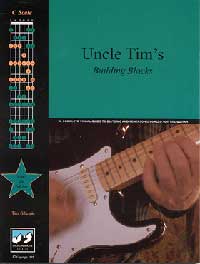
Simply! Here is the concept behind every page of UTBB.
On the fretboard of the guitar is a pattern of notes, once you learn it, you have immediate access to every scale in every part of the fretboard, for every key.
One for diatonic scales and one for pentatonic scales.
And it is easy to learn the pattern if you look at a picture of it, and music theory is what creates this pattern. This approach makes it super easy! Super easy!
There is nothing like it and nothing can make up for it. For $20, you can put this all to rest right now. Pick up a copy today.
eBooks are delivered instantly!
This month we will take a look at playing out of the "box" position. The box position is well suited for this. With a little help you may be able to combine this with the other pentatonic information you already know.
If you look at the work of B.B. King you will quickly see that he and Lucille play inside of the box positions quite a bit. The box position is a subset of notes found in the pentatonic signature. It is more of a location than anything else. This is a very small pattern of notes that offers good creativity of choices. I have hesitated to write a column about this because it is a very skinny subject, however, this application of theory has wide scale appeal and many uses for guitarists. So even though this will be a shorter newsletter than most, the information is still very valuable.
If you have been playing in diatonic and pentatonic signatures I think you will find that this application can be great fun if you practice within and outside the box. When used in conjunction with the twelve bar blues discussed last month, the box pattern will provide opportunities to play on top of it.
 Box patterns can
be played in any pentatonic signature. In this case it is C major we are
working out of as an example. I think you will find there are more examples
of box playing in A and E major, however the key is not the point I am
trying to make. Boxes can be located in any key. Boxes occur in each key
in specific areas of the fretboard. A box is just a generic term for a
small selection of notes in a favored position. You could probably call
any group of notes similar to these "boxes". The examples listed
here are the common ones I have seen and used for years.
Box patterns can
be played in any pentatonic signature. In this case it is C major we are
working out of as an example. I think you will find there are more examples
of box playing in A and E major, however the key is not the point I am
trying to make. Boxes can be located in any key. Boxes occur in each key
in specific areas of the fretboard. A box is just a generic term for a
small selection of notes in a favored position. You could probably call
any group of notes similar to these "boxes". The examples listed
here are the common ones I have seen and used for years.
Many guitarists use and work out of boxes, not just to repeat phrases or songs but also to improvise a guitar part or construct a solo. What is next most important is to stress the relationships that exist in this confined space.
There are two relationships I want to stress in this column. The first is the relationship with the rest of the scale and key. When I use the box positions for leads, it is usually only for a short while and then I move to another location. I may come back a few times but I use this selection lightly. Other guitarists will camp out here and milk this position of notes for all it's worth. B.B. King is probably the most famous of these players.
Another way to examine relationships is to look at the notes within the box.
The first example of notes is located between frets 7 and 10 in this key. The tonic note (C) is present as is G, (the dominant). And the relative minor note (A) is here too. The Supertonic (D, 2nd degree) is also present. Keep in mind there are only five notes in this scale, so four of the five are right here in this pattern without moving. The fifth note is E and it is right next to this box. Some people include this note in the box as well. No wonder guitarists can spend so much time in the box. All the notes of the scale are right there.
The second example is shown between the frets of 15 and 17. This is probably
the most common example of "box" playing. This exact same box
can also be found between frets three and five. Remember the fretboard
repeats every twelve frets and this example hints at some good uses for
this piece of information. You can play this same box high up the neck
or down low close to the open strings.
In the past I have stressed how large movements across the fretboard are not necessary for creative statements. This example is a good opportunity to illustrate that premise. Here are some things you can try.
Start out playing slowly
Try playing slowly out of these positions and make every note count. Since there are only a few notes we are working with, there is no need to speed around. Go slowly at first and select every note carefully.
Bend some notes
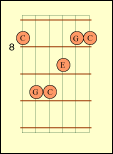 This is also a
great opportunity to bend a few notes as you play inside the box. In the
low position play the C note with your index finger and bend the D note
with your third or ring finger. Notice if you bend the D note a whole
step, you will change it to an E note. Using this move against the tonic
chord can be strong. Remember the tonic chord contains a major third (C
and E) and bending up to the E note can work well with this chord. The
tonic chord example is shown to the right. Remember when you change keys,
these boxes will still be present and this chord form will be right where
it is in relation to the box. This will always hold true.
This is also a
great opportunity to bend a few notes as you play inside the box. In the
low position play the C note with your index finger and bend the D note
with your third or ring finger. Notice if you bend the D note a whole
step, you will change it to an E note. Using this move against the tonic
chord can be strong. Remember the tonic chord contains a major third (C
and E) and bending up to the E note can work well with this chord. The
tonic chord example is shown to the right. Remember when you change keys,
these boxes will still be present and this chord form will be right where
it is in relation to the box. This will always hold true.
Here is a not so obvious relationship that has great bearing on this approach using example 1. The fourth chord in this key is an F major chord. An F seventh will contain these notes, F, A, C and Eb. When you bend the D to an E note and then hit the F 7 chord, you get a major third to seventh sound. This is something B.B. King used extensively. It is a very strong move and well accepted. However it requires a little thought and practice before you can rip this off in a jam session. This is not my idea, it has been used time after time and is a standard but advanced move.
It is interesting to note we are constructing passages referencing the F 7 chord and working in the C pentatonic scale. F is not a note that is in the C major pentatonic scale but it is still relevant because in the key of C diatonic, F is the fourth. The chords will probably all be from C diatonic.

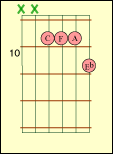
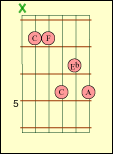
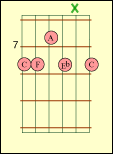 Hammer
on's and pull offs
Hammer
on's and pull offs
Okay I know I said to start slowly. Playing hammer on's and pull offs can easily inject speed. But try to go through the motions slowly, and concentrate on the motions not the speed. Barre the C and G notes with your index finger and hammer the D and A notes with your third finger. Be as clean as you can when you hammer.
Pick a few notes and expand the possibilities.
Use this as an opportunity to add other notes to this box and sample some combinations. Using only four notes is easy because it severely limits the notes available. This can be good because you do not have to worry about moving much. Just play the four notes and look for the chance to add an additional note or two as you go.
Vibrato
Vibrato is the sound you get from slightly moving your fretboard hand (back and forth) as you continue to play the note. You do not move your hand so far that you dampen the string but rather just enough to make the note waver.
Play this over the twelve bar blues
Last month we examined the twelve bar blues. If you are looking for an appropriate lead type to use on top of the twelve bar blues, this is it. Have a friend play the chord progression and place some leads over it. Try it at different areas of the progression. You may find this box position works better over some chords than others. The relationships between the notes of the chords and the notes of the lead will form relationships or work against each other. There are a lot of different relationships we could explore but the proof is in experimentation.
Although there are only a few notes to consider, they bleed over into everything else pentatonic and diatonic key based to form complex relationships. So try this for yourself and see what happens.